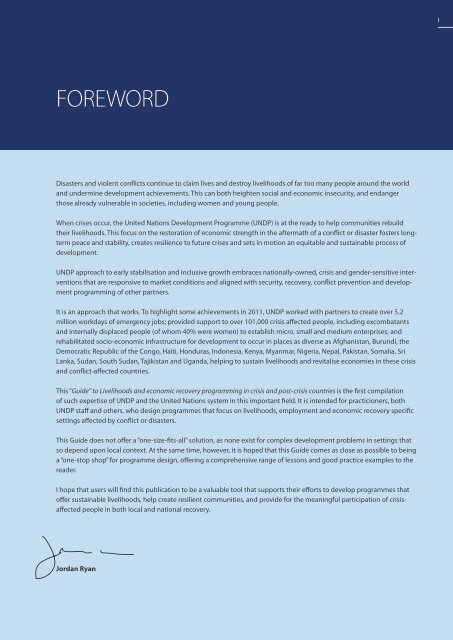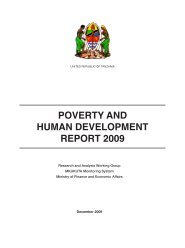Download PDF (4.08 MB) - ReliefWeb
Download PDF (4.08 MB) - ReliefWeb
Download PDF (4.08 MB) - ReliefWeb
Create successful ePaper yourself
Turn your PDF publications into a flip-book with our unique Google optimized e-Paper software.
i<br />
FOREWORD<br />
Disasters and violent conflicts continue to claim lives and destroy livelihoods of far too many people around the world<br />
and undermine development achievements. This can both heighten social and economic insecurity, and endanger<br />
those already vulnerable in societies, including women and young people.<br />
When crises occur, the United Nations Development Programme (UNDP) is at the ready to help communities rebuild<br />
their livelihoods. This focus on the restoration of economic strength in the aftermath of a conflict or disaster fosters longterm<br />
peace and stability, creates resilience to future crises and sets in motion an equitable and sustainable process of<br />
development.<br />
UNDP approach to early stabilisation and inclusive growth embraces nationally-owned, crisis and gender-sensitive interventions<br />
that are responsive to market conditions and aligned with security, recovery, conflict prevention and development<br />
programming of other partners.<br />
It is an approach that works. To highlight some achievements in 2011, UNDP worked with partners to create over 5.2<br />
million workdays of emergency jobs; provided support to over 101,000 crisis affected people, including excombatants<br />
and internally displaced people (of whom 40% were women) to establish micro, small and medium enterprises; and<br />
rehabilitated socio-economic infrastructure for development to occur in places as diverse as Afghanistan, Burundi, the<br />
Democratic Republic of the Congo, Haiti, Honduras, Indonesia, Kenya, Myanmar, Nigeria, Nepal, Pakistan, Somalia, Sri<br />
Lanka, Sudan, South Sudan, Tajikistan and Uganda, helping to sustain livelihoods and revitalise economies in these crisis<br />
and conflict-affected countries.<br />
This “Guide” to Livelihoods and economic recovery programming in crisis and post-crisis countries is the first compilation<br />
of such expertise of UNDP and the United Nations system in this important field. It is intended for practicioners, both<br />
UNDP staff and others, who design programmes that focus on livelihoods, employment and economic recovery specific<br />
settings affected by conflict or disasters.<br />
This Guide does not offer a “one-size-fits-all” solution, as none exist for complex development problems in settings that<br />
so depend upon local context. At the same time, however, it is hoped that this Guide comes as close as possible to being<br />
a “one-stop shop” for programme design, offering a comprehensive range of lessons and good practice examples to the<br />
reader.<br />
I hope that users will find this publication to be a valuable tool that supports their efforts to develop programmes that<br />
offer sustainable livelihoods, help create resilient communities, and provide for the meaningful participation of crisisaffected<br />
people in both local and national recovery.<br />
Jordan Ryan





